At some point, every homeowner faces the crucial question: “What kind of chimney liner do I need?” The chimney liner that you need will depend on the type of appliance that you have and its current condition. With years of expertise, we’ll guide you through selecting the ideal chimney liner.
Making the right choice can’t be emphasized enough, as it ensures safety, efficiency, and peace of mind. Join us as we explore the importance of choosing the right chimney liner and look into the various sizes and types available to match your home’s needs.
What Kind of Chimney Liner Do I Need?
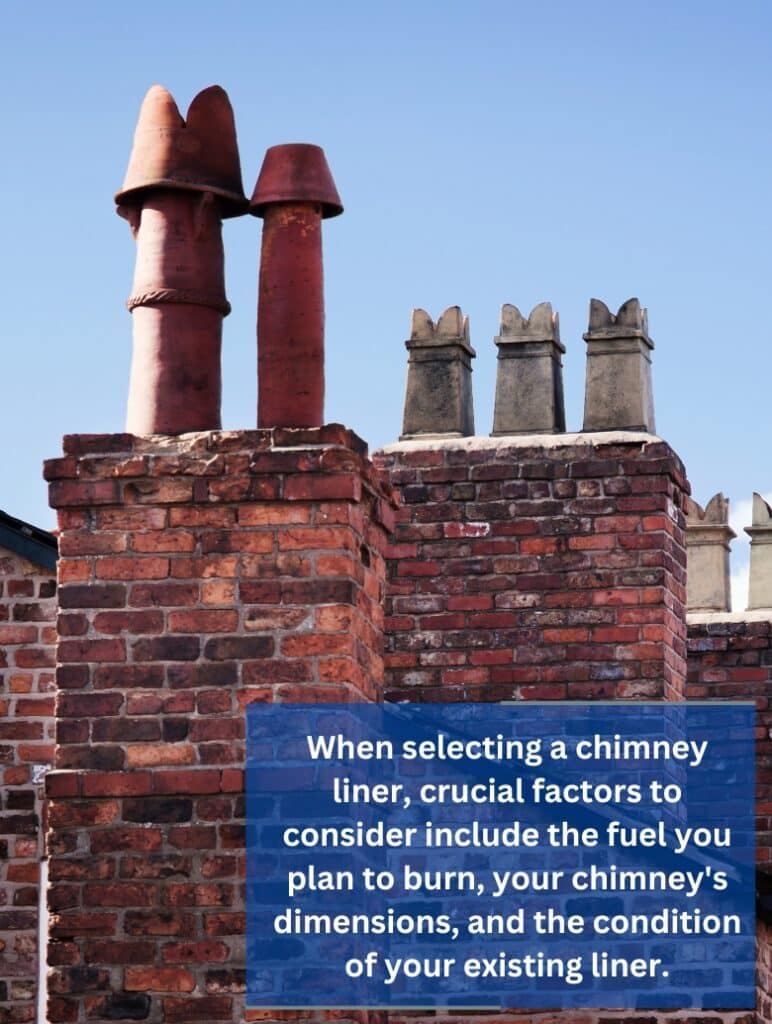
When selecting a chimney liner, there are various chimney relining options available, and each is designed to address specific needs and chimney conditions.
Crucial factors you want to consider are the fuel you plan to burn, your chimney’s dimensions, and the condition of your existing liner. Among the primary chimney liner types are metal, clay tiles, and cast-in-place.
Additionally, there are various chimney relining options available, each designed to address specific needs and chimney conditions.
Stainless steel liners are the top choice, with two common grades: 316 and 904. Grade 316 liners, with a 10-year warranty, cannot withstand smokeless coal burning. In contrast, grade 904 liners, backed by a 20-year warranty, are suitable for smokeless coal, as they remain undamaged and maintain their warranty integrity. Both grades accommodate house coal and wood burning.
Consulting a professional chimney sweep or installer is advisable to determine the right liner for your situation. Here are other key factors you need to consider.
——
Do You Need to Hire Chimney & Fireplace Expert?
Get free quotes from qualified experts near you. No commitment required!
——
Exploring Metal Chimney Liner Types
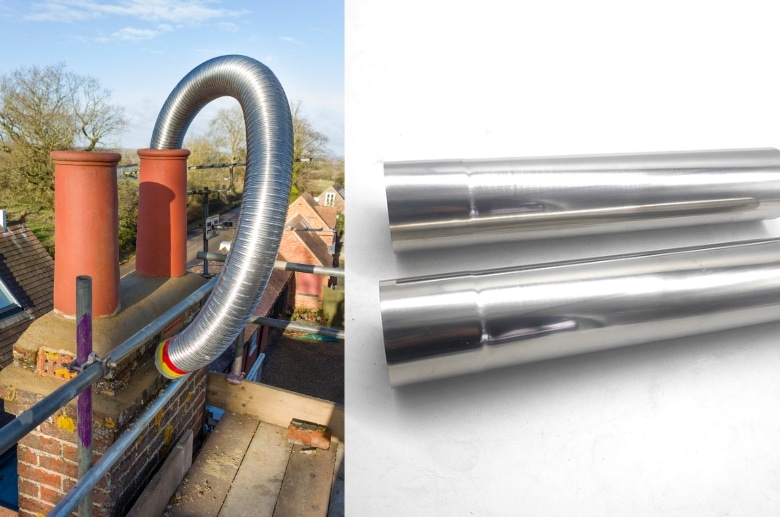
Chimney liners present two primary variants: smooth wall and corrugated. Smooth wall chimney liners are made from stainless steel, whereas corrugated liners are available in aluminum and stainless steel. They each offer distinct advantages and considerations. However, it’s also essential to be aware of potential problems with chimney liners.
Smooth Wall Chimney Liner
Characterized by a dual-wall structure, smooth wall chimney liners consist of an inner and outer wall, forming a robust and heat-efficient design. Key points include:
- Smooth Interior: The inner wall boasts exceptional smoothness, simplifying cleaning and diminishing creosote buildup.
- Rigidity: Smooth wall liners are known for their structural integrity, making them ideal for navigating confined spaces or passing through dampers.
Corrugated Chimney Liner
In contrast, corrugated chimney liners adopt a single-wall construction. While budget-friendly, they harbor unique traits:
- Cost-Efficiency: Corrugated liners are economical as they cost around $15 to $40 per square foot for a total of $360 to $900, which is particularly appealing if cost savings are a priority.
- Flexibility: Their single-wall build allows some flexibility, enabling adaptation to tight spaces.
Crucial Considerations
Several critical factors come into play in making the right chimney liner selection.
Creosote Buildup
If you use your fireplace daily, creosote starts to form. Because of that, it’s important to use smooth wall chimney liners as they tend to exhibit reduced creosote buildup. You can use corrugated liners if you don’t use your fireplace as much.
Draft Enhancement
Smooth wall chimney liners have the potential to enhance your chimney’s draft by up to 20% due to their efficient smoke flow. This heightened draft results in improved combustion and reduced smoke emissions.
Heat Retention
Double-wall construction in smooth wall liners excels in retaining heat compared to single-wall corrugated liners. This property further diminishes creosote buildup and bolsters overall efficiency.
Making the Informed Choice
Ultimately, deciding between smooth wall and corrugated chimney liners hinges on specific needs and budget considerations. Here’s a straightforward guideline.
Choose Smooth Wall Liner:
- If you need to pass the liner through a damper without compressing it.
- If you use your chimney almost every day and want to prioritize minimal creosote buildup and efficient draft.
Choose Corrugated Liner:
- When working within budget constraints is paramount.
How Do I Choose a Chimney Liner?
As a homeowner or a property owner, you might need clarification about choosing a chimney liner if this is your first time replacing or adding one. Selecting the appropriate chimney liner involves considering both the type of appliance you have and the condition of your chimney.
——
Do You Need to Hire Chimney & Fireplace Expert?
Get free quotes from qualified experts near you. No commitment required!
——
By Type of Appliance
When considering a chimney liner, it’s essential to match it to the type of appliance you have in your home.
1. Fireplaces
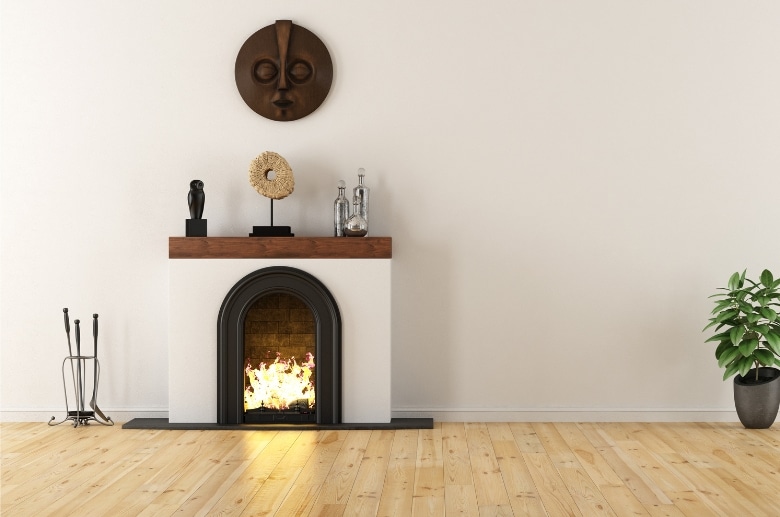
As per the Chimney Safety Institute of America (CSIA), stainless steel liners are suitable for wood-burning and gas fireplaces. However, aluminum liners are restricted to specific gas fireplaces with moderate heating efficiency.
When wood burns, it generates smoke that can carry creosote, a form of soot. If the smoke doesn’t rise quickly enough, creosote can accumulate within your chimney and lead to house fires if not cleaned properly.
A steel liner’s smooth, seamless surface enhances the efficient venting of harmful fumes. Therefore, stainless steel chimney liners are extremely durable and perfect for wood-burning fireplaces, allowing these dangerous byproducts to exit your home safely.
2. Wood Stoves
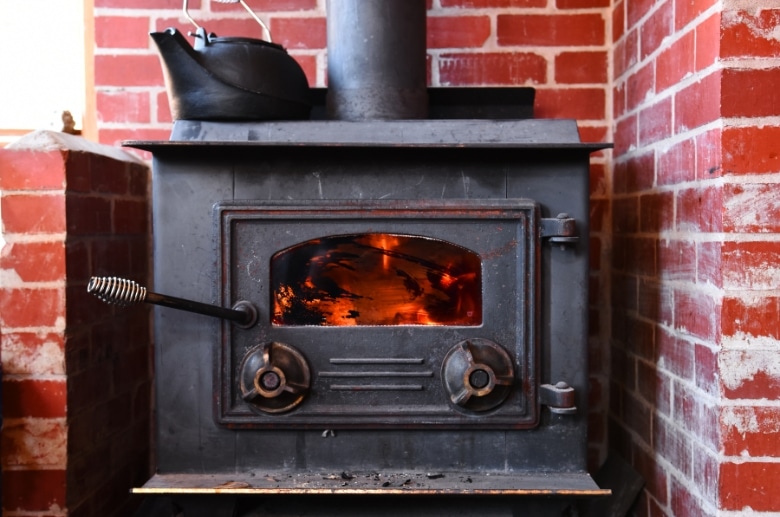
For wood stoves, the top choice is a stainless steel liner. While alternatives like concrete and clay exist, stainless steel flue liners consistently stand out as the top choice due to their efficiency, durability, protective qualities, and cost-effectiveness. When correctly sized for your stove (which usually requires a 6-inch liner), a stainless steel chimney liner ensures optimal ventilation efficiency, contributing to enhanced performance.
When using wood stoves, it’s crucial to connect the flue liner securely to the stove pipe while also considering factors like heat output and draft requirements. The flue liner is vital to your stove’s operation, enabling efficient and safe fuel combustion.
3. Water Heaters and Gas Furnaces
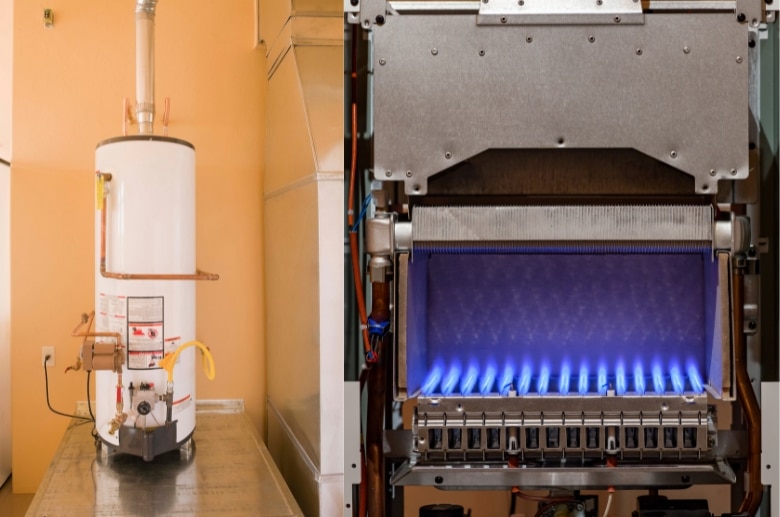
A stainless steel or aluminum liner is the most suitable chimney liner for a gas furnace and water heater. These options are renowned for their safety, durability, and common use in enhancing and refurbishing existing chimneys. Stainless steel liners have an impressive lifespan of 50-100 years, depending on the quality grade of the steel employed.
Moreover, water heaters and gas furnaces have specific code considerations due to their combustion gases. For instance, a typical water heater requires a 4-inch liner, while a standard-sized gas furnace and water heater combination often necessitates a 5 or 6-inch liner. Verifying that the liner’s size matches the appliance is crucial to avoid issues like back drafting and condensation. Consequently, altering your furnace might also entail replacing the connected liner.
By Chimney Condition
To ensure the safety and efficiency of your chimney, you should also consider the current condition of your chimney when choosing a chimney liner.
Existing cracks or damage
If your chimney’s masonry has cracks or the flue clay tiles are damaged, it’s essential to address these issues before installing a liner. To avoid this, chimney experts widely advise choosing stainless steel chimney liner replacements, often backed by a lifetime warranty. Aluminum liners may be a more budget-friendly choice, but they are primarily suitable for only specific gas heating appliances.
The liner’s effectiveness could be compromised if the chimney structure isn’t in good condition. If the chimney is damaged, it can lead to water infiltration, leaking gases, and chimney fire, which can also damage your new liner and lead to additional repairs.
Corrosion concerns
When condensation occurs due to burning improper fuel or inadequate chimney construction within a chimney, it leads to masonry deterioration and structural issues, and corrosion develops in your chimney.
Elevated acid levels within flue gases can erode mortar joints in a chimney. This erosion can lead to swift heat transfer to nearby combustible materials and the potential leakage of harmful gases like carbon monoxide into the living areas of your home.
If you’re worried about corrosion, cast-in-place liners would be the best fit for you. They stand out for their remarkable resistance to corrosion induced by the byproducts of burning gas and oil, a quality not as inherent in stainless steel or clay liners.
What Size Flue Liner Do I Need?
Determining the correct flue liner size is crucial for safe and efficient chimney operation. Let’s explore the key considerations to find the right fit for your specific needs.
Flue size vs. liner size
The correct flue size is usually based on the appliance or stove’s exhaust outlet. When sizing a chimney liner, it’s important to ensure it’s not smaller than the appliance’s exhaust hole or more than three times its area, as this will guarantee ample space for smoke to flow and for proper draft development.
Typically, the flue size should be a quarter (25%) larger than the stove pipe size connecting the stove to the chimney. For example, if you have a stove with an 8-inch diameter pipe, it would need at least a 10-inch flue. Similarly, a 10-inch stove pipe necessitates a 12-inch flue, and so on.
An accurately sized liner reduces creosote build-up by up to 60%, improving safety and efficiency. Moreover, using a liner sizing chart and guidelines specific to your appliance type ensures a proper fit and optimal functionality.
Round liner dimensions
Here are the steps to determine the right size for your round chimney liner:
- Measure from the top of the chimney crown to the thimble or opening of your appliance or stove using a tape measure. It’s a good practice to add a foot or two as a buffer to ensure flexibility in adjustment.
- Verify the width and length of the chimney flue at the top of the chimney to confirm that the liner size you’ve chosen matches the flue’s dimensions.
- If you’re installing a liner for a wood application, consider the need for insulation. Ensure enough space to accommodate a 1/2-inch thick top wrap insulation and mesh around the liner, or leave a 1-inch gap around the chimney liner for top-mix poured insulation.
- Consider any bends or turns within the flue during your measurements. These should also be factored in for an accurate fit.
Adjustments for specific appliances
If you have a non-round flue liner, here’s how you can find its dimensions.
- Find the minor outside dimension and major outside dimension of your liner, which is the diameter of your appliance’s exterior and interior, respectively.
- Then, use these measurements and refer to a liner sizing chart. This process will provide you with the required round pipe size. For fireplace inserts, a 6-inch diameter chimney liner is typically needed, while wood stoves generally require a liner with a diameter between 6 to 8 inches.
For furnace liners, here’s how to find its dimensions.
- Start with the chimney’s height. Measure from the chimney’s top to the thimble’s top, and add 3.5 inches for the liner’s clamping.
- Then, measure the exact inside flue measurement where the liner will go. Always measure the flue’s inside dimensions to ensure accuracy rather than making assumptions.
——
Do You Need to Hire Chimney & Fireplace Expert?
Get free quotes from qualified experts near you. No commitment required!
——
Chimney Liner Options
The main chimney liner types are clay tile, steel, aluminum, and cast-in-place.
Choosing the right chimney liner involves considering various options tailored to your heating system. Here’s an overview of the main types of chimney liners available.
1. Clay Tile Liners
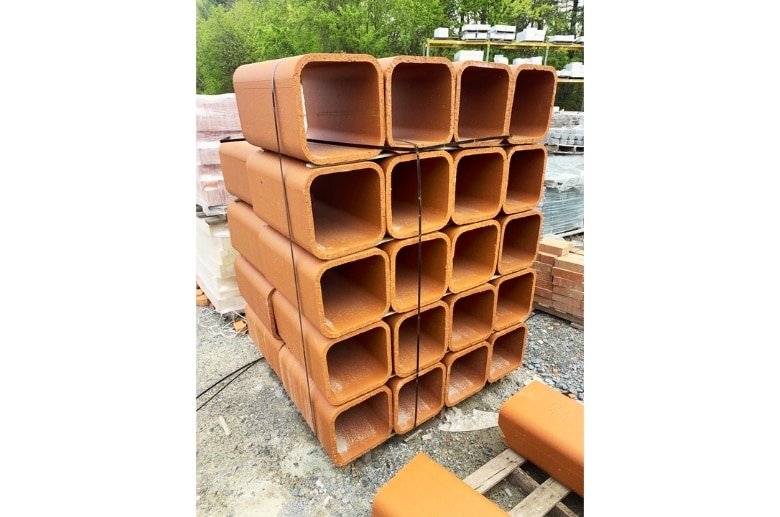
Clay tile liners are a traditional choice for masonry chimneys. They can withstand high heat and corrosive byproducts from various fuels. When properly built with refractory mortar, these flues can last over 50 years with minimal maintenance beyond regular cleaning.
Clay liner tiles are budget-friendly as the materials usually cost around $10 to $20 per square foot. However, the savings on materials could be offset by installation labor costs, which average from $2,000 to $3,500. Retrofitting clay flue liners into existing chimneys, particularly if they’re not straight, can be challenging.
2. Stainless Steel Liners
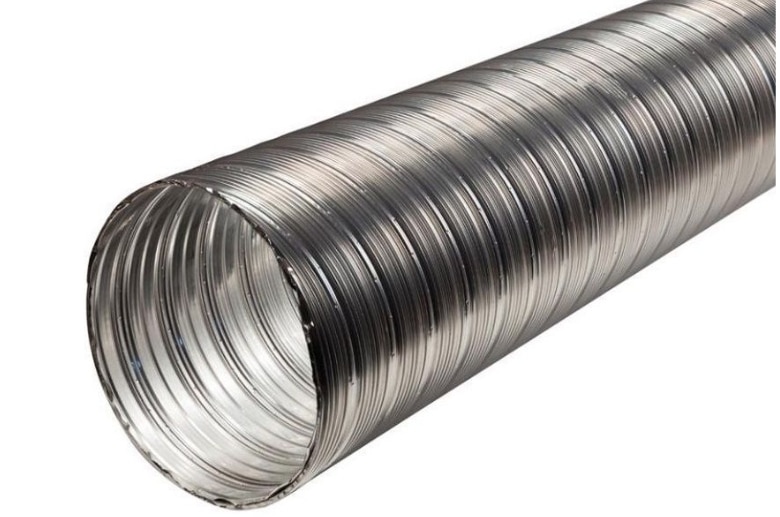
Stainless steel chimney liners, whether rigid or flexible, serve to fix or replace damaged flues. They’re often used in masonry chimneys where clay tiles are cracked or mortar joints deteriorate. On average, they cost between $25 and $100 per square foot, and installation costs range from $1,425 to $5,200.
Stainless steel liners are also suitable for chimneys without flue tiles. There are two common grades: 316 and 904. The variation between 316 and 904 liners lies in the makeup of the stainless steel layers within the liner. Stainless steel is formed by blending iron ore, silicon, nickel, chromium, molybdenum, and carbon to create steel with enhanced corrosion resistance compared to other types.
When deciding between a 316 and a 904 flue liner, it comes down to the fuel type and usage. Grade 904 is preferable for specific conditions, such as extended slumber burning or use with wet wood, while a well-maintained 316L liner usually suffices for most household stove setups.
3. Aluminum Liners
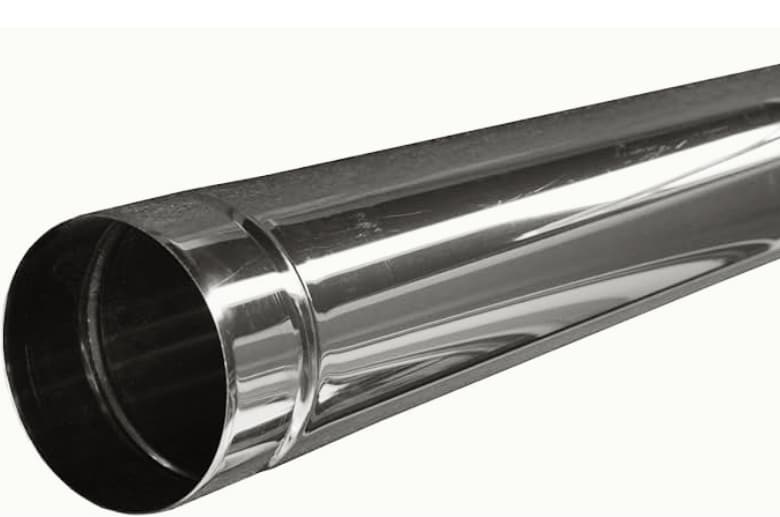
Aluminum chimney liners are designed for gas appliance venting. They’re not suitable for wood-burning fireplaces due to high temperatures. When used correctly, they offer a 15-year limited warranty.
They are lightweight and cost-effective (priced at $15 to $50 per square foot, averaging at $675 to $2,265 with installation), but they may only be suitable for some fuel types due to their lower durability. Aluminum chimney liners are usually suitable for appliances with an efficiency rating below 83%.
4. Cast-In-Place Liners
Cast-in-place liners are highly resistant to heat, acids, and condensation, regardless of the fuel type. Due to their insulation properties, these flue liners maintain higher temperatures, leading to cleaner burns and reduced creosote buildup.
Poured-cement flues can last at least as long as clay tiles, typically 50 years or more. Cast-in-place liners have an average price of $200 to 250 per square foot, and you can expect a total of $5,000 to $7,000, including installation.
Are Chimney Liners Required by Code?
Most regions have building codes mandating chimney lining; failure to comply may result in fines or insurance complications. Additionally, many chimney sweeps decline to clean unlined chimneys due to potential liability issues.
According to the National Fire Protection Association Code 211, chimneys should be lined. Even if not required by local codes, it is advisable to have your chimney lined for safety and enhanced efficiency. If you are still determining the status of your chimney’s lining, having a professional sweep inspect it is recommended. This proactive step ensures your fireplace system’s safety and optimal performance.
Conclusion
Selecting the right chimney liner is crucial for the safety and performance of your heating system. Each type of liner has its benefits and limitations, so it’s essential to consider your appliance, fuel type, and chimney condition when making your choice.
A properly chosen and installed liner enhances the efficiency of your heating system, protects against damage, and contributes to the overall safety of your home. If you need help determining which liner is best for your situation, consulting a chimney professional can provide tailored advice and ensure you make an informed decision.






